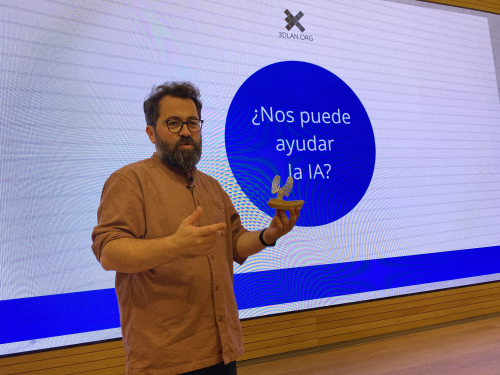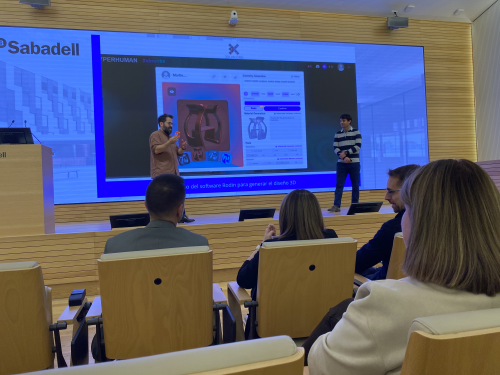Can people with a disability or major mobility limitations make use of 3D design and printing? Yes, according to the spirit of the final session of the DisruptIA Cycle, a series of conferences hosted by the Analytics and Artificial Intelligence team at Banco Sabadell on exploring the virtues of Artificial intelligence (AI) aimed at the bank's professionals. The directors of 3DLAN, Egoi Azkarraga and Alberto Martínez, came to corporate headquarters in Sant Cugat del Vallés to give a conference on AI-assisted inclusive design and convey a hopeful message: artificial intelligence can help improve the life quality of the people who need it the most, thanks to personalised solutions.

For several years, the Basque association 3DLAN (www.3dlan.org) based in Getxo has been engaged in designing and producing, thanks to the limitless possibilities of 3D printing, all manner of objects that can ease the day-to-day lives of people suffering from different types of disabilities, with the overarching aim being to bring them autonomy and independence. Its directors are carrying out this mission in collaboration with a number of schools and vocational training centres, which can then focus their academic projects to addressing real needs and helping others. Some of the many outstanding projects that have become AI applications include:
- Joystick for better wheelchair handling
- Special supports to provide the disabled with access to music therapy classes
- Spoons adapted to special needs
- Accessories that allow people with reduced mobility to cut up meat and eat autonomously
- Supports for the better holding of glassware on wheelchairs

Most of these projects emerge out of designs conceived originally by their end users. Once completed, 3DLAN shares the files that allow these to be 3D printed on its website, as well the entire previous creation process (so that the end product can be adapted, if so desired), which means anyone can download it if they need to.

New possibilities derived from the emergence of AI
Until now, the process of creating a 3D printing process was relatively technical and required specialised knowledge. However, this is one of the many things that seem destined to change with the emergence of artificial intelligence. Members of 3DLAN have already experienced this by using artificial intelligence applications that can transform pencil drawings on paper, which AI then converts into computer models that 3D printers can read. There have even been attempts at creating objects using artificial intelligence chat systems, such as ChatGPT, via spoken instructions.
Although the results are still far from perfect, as Egoi Azkarraga and Alberto Martínez explained in their talk, the initial experiences are quite hopeful. In a relatively short period of time, certain final results have been reached by AI applications which not so long ago took several hours’ work by highly qualified professionals. This means that it will soon be possible for even people with some sort of disability to design what they need to print in 3D autonomously.
With very basic information, whether it is by drawing on a piece of paper, giving some verbal instructions (voice recognition) or even, in some very specific cases in which one has physical mobility nor capacity for verbal expression, using software that converts eye movement into text, AI is capable of interpreting messages and creating tangible objects. There have already been some successful experiences in this regard. All of this is evidence of generative AI's limitless potential for people who have some major disability. According to Egoi Azkarraga and Alberto Martínez, they have a very bright future ahead.